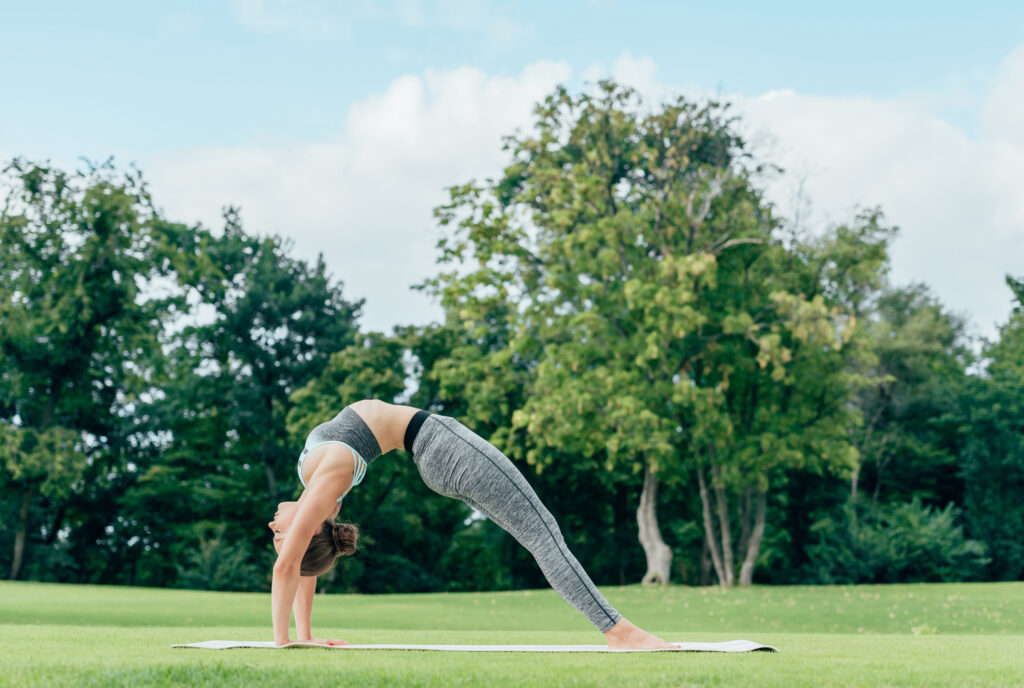Urdhva Dhanurasana: let’s get into it

Urdhva Dhanurasana, mostly known as wheel pose, can be directly translated from the Sanskrit. Urdhva meaning “upward”, and dhanu stands for “bow”, therefore also known as upward bow pose.
It is an intermediate asana, that must be used in a responsible way! It’s strong for both back and shoulders, and a good knowledge of our body strength and reactions is necessary. People with lower back problems, or even going solely through a muscular fragile phase, must be conscious when doing it.
Receive all our tips by email!
Love Astrology? Subscribe Now and Receive Exclusive Content!
In order to be able to always do the right choice for you, read more and learn about Urdhva Dhanurasana.
Urdhva Dhanurasana: step-by-step
As mentioned before, Urdhva Dhanurasana is to be made consciously. That explains the first point itself.
- The beginning position must be prepared carefully: feet parallel, hip-width apart, hands bellow the shoulders next to the ears, and elbows pointing the sky. It’s important to avoid elbows to wide.
- Pressuring feet and hands against the floor, the body raises to an intermediate position, where you can rest the head on the floor.
- Pressuring one more time feet and hands, tailbone and shoulder blades against your back, exhale and lift your head off the floor and straighten your arms.
- While in the position, keep your drsti (the eyes) in the nose, or on your hands. Extend the neck as if you wanted to bring the top of the head against the floor (this action will prevent neck injuries).
- Narrow the hip points and lengthen the tailbone toward the backs of the knees. Lift the pubis up.

Urdhva Dhanurasana cautions and tips
Don’t do Urdhva Dhanurasana if you suffer from:
- Back injury;
- Heart problems;
- High or low blood pressure;
- Recent surgeries;
- Lack of flexibility.
Once you start feeling comfortable with the process of the asana, is time to improve your wheel pose. Follow some of these tips and check which ones suit you better.
- Use a block between your tights and press it to awaken the consciousness of the action of the adductor in the pose. The adductors help to keep the correct alignment between the knees and hips;
- If you feel comfortable in the pose, try to fake the movement of slipping the feet out (keep it still!), which will result in the internal rotation of the thighs;
- Press the heels against the floor to improve the pose;
- The action of pulling the hands against the feet (always as an intention of movement, but never actually moving) deepens the pose, it can be followed by shoulders flexing, which will allow the chest to open;
- Even though Urdhva dhanurasana promotes the stretching of the abdominal musculature, a soft contraction is important to protect the lower back (will stretch the lower back).
When it comes to breathing, it’s suggested by teachers that you deepen your breaths. This task is not easy and it can take you years to master. Stay calm and keep the intention in your mind, whether you can fulfill the intention or not. Consequently, the focus of this asana must be to open the chest. The deep and conscient breathing in hyperextension helps in the process of opening the ribcage.
The tradition suggests repeating the pose from three to five times, in order to master the asana and feel more freedom in the movement. Despite that, considering the intensity of Urdhva Dhanurasana, we need to make good management of the use of this pose. Use it well, and enjoy all it can bring to you!
You may also like:
- Yoga: the ultimate guide for types and benefits
- Malasana pose: why and how to include it in your daily routines
- Pascimottanasana: the West Back Stretching
- Urdhva Mukha Svanasana: get to know the Face-Up Dog Pose

